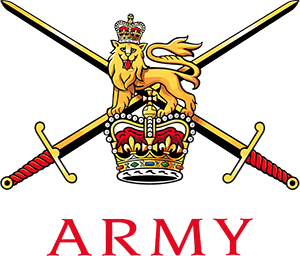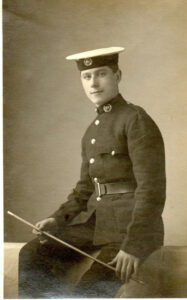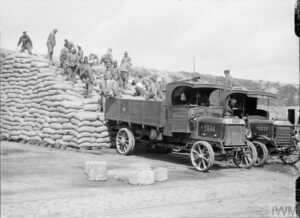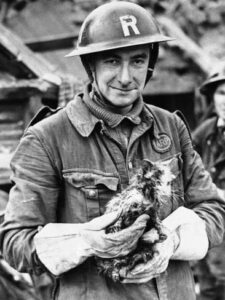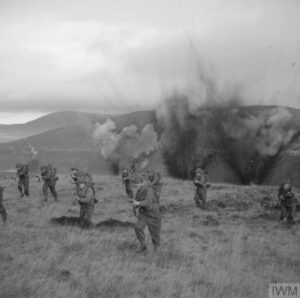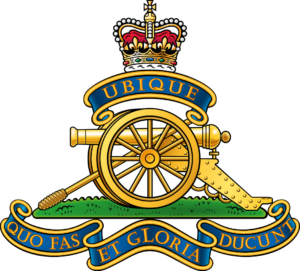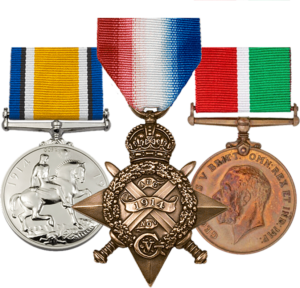To fully understand the service history of any individual, it is useful to have a basic understanding of the organisation and rank structure of the British Army.
Army structure
A hierarchical structure ensures the effective command and control of large military forces, allowing for the coordination of complex operations across various units and support elements.
- Section: the smallest organisational unit, typically consisting of 7-12 soldiers and forming part of a platoon. Sections are usually commanded by a corporal or sergeant.
- Platoon / Troop: consists of 3-4 sections and typically includes 25-30 soldier. A platoon is commanded by a Lieutenant or Second Lieutenant.
- Company / Squadron / Battery: made up of at least two platoons or troops and typically comprising 100-150 men. Companies are usually lettered A through D and commanded by a Major or a Captain. In the cavalry, this unit is referred to as a squadron, and in the artillery, it is known as a battery.
- Battalion: a regimental sub-unit of infantry amounting to between 500 and 1,000 soldiers. It normally consists of a headquarters and three or more companies. Traditionally, most British regiments have had more than one battalion, but different battalions of the same regiment have seldom fought together. A battalion is normally commanded by a Lieutenant Colonel.
- Brigade: a formation consisting of three infantry battalions or three cavalry or armoured regiments. During the World Wars a brigade numbered between 3,500 and 4,000 soldiers. When forming part of a division, a brigade has no internal support elements, but when operating independently (usually called a brigade group), it includes supporting reconnaissance, artillery, engineers, supply and transport units. A brigade is commanded by a Major-General or Brigadier.
- Division: made up of three infantry, cavalry or armoured brigades. Divisions are usually equipped to operate independently in the field and have a full complement of supporting reconnaissance, artillery, engineers, medical, supply and transport troops. During the World Wars, the average British division numbered around 16,000 soldiers. Divisions are commanded by a Lieutenant-General or Major-General.
- Corps: a tactical formation made up of two or three divisions and commanded by a Lieutenant-General. Corps are normally identified by Roman numerals. During the First World War the British Army grew to encompass 22 corps.
- Army: an army is a formation consisting of two or more corps and commanded by a General or a Field Marshal. An army in the Second World War numbered about 150,000 soldiers. Eleven British armies were formed during the First World War. More than one army operating together is known as an Army Group.
Ranks
As might be expected for such an old organisation as the British Army, the ranks used have changed over time. Below I outline the main categories of rank as might be useful for a family historian – for detailed information visit Wikipedia.
- Private: the lowest rank in the army. As most units in the British Army have long traditions some variation has developed in the terminology, e.g. Trooper, Guardsman, Gunner, Fusilier, Rifleman etc.
- Junior NCOs: a non-commissioned officer is a military officer who does not hold a commission and so earn their position of authority by promotion from Private. Junior NCOs include Lance Corporal and Corporals and generally command a section or a single tank. In peacetime it can take 6-8 years of service to reach this position. The Royal Artillery often uses the ranks Lance Bombardier and Bombardier instead.
- Senior NCOs: Sergeants are usually the second in command of a platoon. Each company will normally have a more senior sergeant who acts as the senior NCO. Depending on their unit they are known as Staff Sergeant, Colour Sergeant and Sergeant Major. Some specialist roles also have their own ranks such as Quartermaster Sergeant.
- Warrant officers: the highest-ranking group of non-commissioned ranks who generally have senior management roles with companies or battalions. There are two classes, WO1 and WO2, although the terminology used again varies by unit, including Regimental Sergeant Major, Staff Sergeant Major, Regimental Quartermaster Sergeant etc.
- Subalterns: these are junior officers below the rank of captain and generally comprise the various grades of lieutenant. They usually command platoons or troops.
- Field officers: these are the middle-ranking group of commissioned officers above junior officer ranks but below general officers.
- General officers: the most senior commanders of the army.

